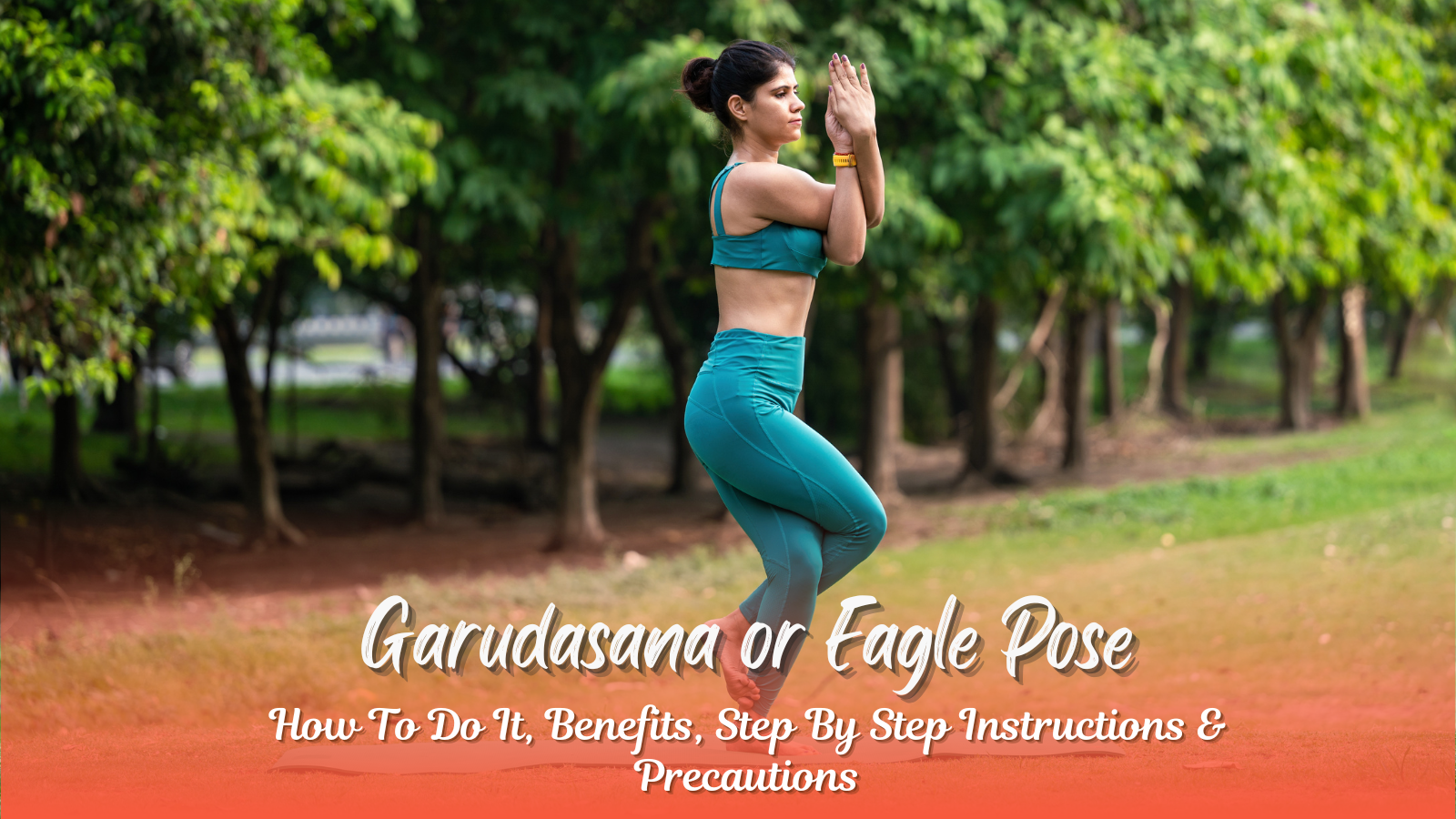Garudasana, commonly known as Eagle Pose, is a powerful standing yoga posture that requires balance, flexibility, and concentration. This pose offers numerous benefits for the body and mind, helping to improve both physical strength and mental focus. In this guide, we’ll explore how to perform Garudasana, its benefits, and how it can elevate your yoga practice. If you’re also looking to deepen your yoga knowledge, consider enrolling in the Best Yoga Teacher Training in Rishikesh, with options such as the 300 Hour Yoga Teacher Training in Rishikesh or the 500 Hour Yoga Teacher Training in Rishikesh.
What is Garudasana (Eagle Pose)?
Garudasana is derived from the Sanskrit word Garuda, which refers to the eagle, and Asana, which means pose. Just like an eagle soaring high in the sky, this pose symbolizes strength, grace, and sharp focus. By practicing Garudasana, you align your body and mind, achieving a sense of stability and calm. As you move through the pose, you’re not just working on your body; you’re also honing your mental clarity.
Step-by-Step Guide to Garudasana (Eagle Pose)
To fully experience the benefits of Garudasana, follow these simple steps to correctly execute the pose:
Start Standing Tall: Stand with your feet hip-width apart and focus on a point in front of you to help with balance.
Cross Your Right Leg Over Left: Lift your right leg and cross it over your left thigh. If possible, hook your right foot behind the left calf.
Bend Your Left Knee: Slightly bend your left knee to stabilize your body while balancing on one leg.
Engage Your Arms: Extend your arms forward and cross your right arm over your left at the elbows. Bend your arms so your palms face each other.
Bring Palms Together: If possible, press your palms together. Keep your shoulders aligned with your hips and your gaze steady.
Hold and Breathe: Focus on your breath, maintaining this position for a few breaths before gently releasing.
Repeat on the Other Side: Switch legs and arms, repeating the steps.
Garudasana Benefits for the Body and Mind
Garudasana is not only beneficial for flexibility but also helps in improving strength, balance, and focus. Let’s break down the Garudasana benefits in detail:
Improves Balance and Stability: By balancing on one leg and crossing the other leg, you enhance your sense of coordination and body control.
Increases Flexibility: This pose stretches the hips, thighs, back, ankles, and shoulders, helping to increase flexibility in these areas.
Strengthens Core and Legs: The muscle engagement in the standing leg and core muscles helps build strength and stability.
Improves Digestion: The twisting nature of the pose stimulates the digestive system, aiding in better digestion and detoxification.
Calms the Mind: The focus required in Garudasana helps to clear mental clutter and reduce stress, making it a great pose for mental clarity.
Enhances Concentration: Holding the pose with focus and steady breathing helps develop concentration and mental discipline.
Garudasana Chakra Connection
Garudasana is known to activate the solar plexus chakra (Manipura), located in the upper abdomen. This chakra is associated with personal power, self-esteem, and confidence. By practicing Eagle Pose, you stimulate this chakra, enhancing your ability to manifest personal goals and build inner strength. Regular practice can help you connect with your personal power, aligning you physically and mentally.
Garudasana Mythology and Symbolism
In Hindu mythology, Garuda is a divine bird and the mount of Lord Vishnu. Known for his speed and strength, Garuda represents the power of transformation. By embodying Garudasana, you tap into this transformative energy, gaining the strength and focus to overcome obstacles, just like Garuda did when he rescued his mother from the serpent king.
Key Benefits of Garudasana Eagle Pose
The Garudasana Eagle Pose benefits are numerous, impacting both the body and the mind. Regular practice can lead to the following:
Strengthen your legs, ankles, and core: These areas are key to maintaining balance during the pose, and strengthening them provides better overall stability.
Improves posture: The pose encourages proper alignment of the spine and opens the chest, promoting better posture.
Detoxifies and rejuvenates: The twist in Garudasana aids in detoxification and increases energy flow in the body.
Reduces stress: Focus and breathing techniques while in the pose help calm the nervous system and reduce anxiety.
To make the most out of Garudasana and avoid injury, follow these tips:
Tips for a Safe Practice of Garudasana
Incorporating Garudasana into Your Yoga Practice
Warm-Up Properly: Before attempting Garudasana, warm up your body with gentle stretches and poses such as Sun Salutations.
Start Slow: If you’re a beginner, don’t rush into the full expression of Garudasana. Start by practicing the basic balance and progressively deepen your stretch.
Engage Your Core: Properly engage your core muscles to maintain balance and prevent strain on your back.
Focus on Alignment: Ensure your knees are aligned with your ankles and your hips are stacked over your shoulders.
Use Props for Support: If you’re still building strength and flexibility, use props such as blocks or straps to help you get into the pose safely.
Avoid Overstretching: Never force yourself into the pose. Gradually increase your flexibility with time and practice.
Garudasana is a valuable addition to any yoga sequence, especially for those working on improving balance, flexibility, and mental focus. To incorporate it effectively into your routine, you can pair it with other poses such as Warrior I (Virabhadrasana I) and Tree Pose (Vrikshasana) for a balanced flow. Remember, consistency is key in yoga practice, and with time, you’ll feel more comfortable and stable in this pose.
If you’re looking to deepen your yoga journey and teach this powerful pose to others, enrolling in a 200 Hour Yoga Teacher Training Course in Rishikesh can provide you with the skills and knowledge to guide students in their practice. The teachings from this course will not only improve your personal practice but will also empower you to teach others effectively.
Conclusion: Mastering Garudasana for Strength and Balance
Garudasana is a challenging yet rewarding pose that can greatly enhance your yoga practice. Whether you’re looking to improve your balance, flexibility, or mental clarity, this pose offers incredible benefits for both the body and mind. As you integrate Garudasana into your routine, take your time, practice consistently, and remember to listen to your body.
For those looking to deepen their yoga knowledge and practice, enrolling in the Best Yoga Teacher Training in Rishikesh can help you master Garudasana and many other asanas. Whether you choose a 300 Hour Yoga Teacher Training in Rishikesh or a 500 Hour Yoga Teacher Training in Rishikesh, you’ll be equipped with the skills to teach and practice yoga with confidence.
With patience and dedication, you can master Garudasana, connecting with the energy of the eagle and transforming both your body and mind.
By incorporating Garudasana into your yoga practice and exploring its benefits, you’ll experience a deeper connection with your body and mind. Consider joining a Yoga Teacher Training in Rishikesh to further enhance your practice and knowledge.


